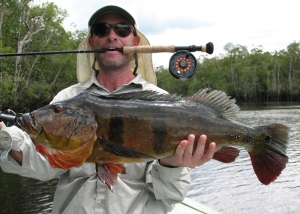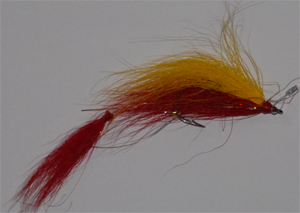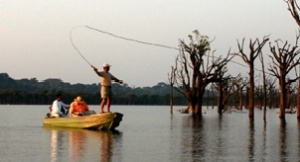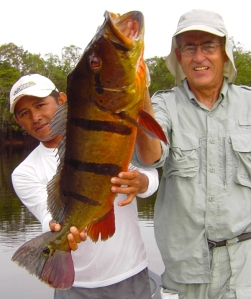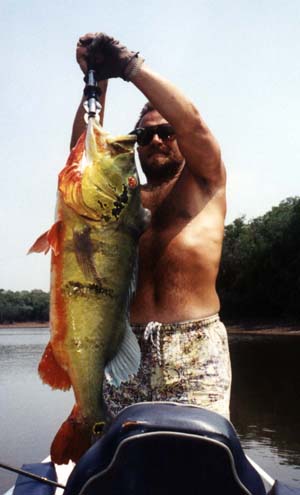Paul Reiss, owner of Acute Angling, talks with Bass-Fishing-Source about fishing the Amazon for peacock bass in part two of an exclusive interview. Read it all below or click here.
Amazon Peacock Bass – The Real Heavy Hitting Monsters
Amazon peacock bass are quite different than anything you will find in the U.S. While the peacock bass in Florida can be great to catch, fishing for Peacock in the Amazon is not only a whole different experience but it’s also a whole different fish.
In our search for information on catching the “bass” that hits your line like a truck, we were lucky enough to get some insight from a true authority in Amazon Peacock Bass, Paul Reiss of Acute Angling.
We got a chance to ask Paul about what it takes to catch Peacocks in the Amazon, including tackle, lures and even some tips and techniques to land your next trophy Peacock. You don’t want to miss what he has to say about giving youself the best chance to land the fish of a life time.
First a quick introduction for those that may not know Paul.

Paul Reiss operates Acute Angling, a unique outfitting company offering guided Amazon fishing trips and explorations. After a conventional entrepreneurial career, he fulfilled a lifelong nature lover’s dream by founding a business that allows him and the anglers he takes along, to explore the world’s vastest wilderness, pursuing its fiercest sportfish and observing firsthand the amazing aquatic life of the Amazon. With two decades of field experience and doctoral study, Reiss is probably the world’s foremost expert on Amazon sportfishing and the amazing peacock bass. His company is focused on finding and accessing pristine waters for Peacock Bass, Payara, giant catfish and other fierce Amazon sportfish.
Find out more about Paul Reiss and his service, Acute Angling.
B-F-S: How long have you been fishing for Peacock Bass?
Paul: Seventeen years. My first visit to Brazil was in 1994. I quickly fell in love with the Amazon and vowed to find a way to spend my time there. The fishing business quickly evolved and along with it my research and conservation projects.
B-F-S: How do Peacock bass in the U.S. differ from Amazon Peacock Bass?
Paul: Basically, they are simply an altogether different species than thegiants we pursue in the Amazon. Even though they are related, they are as dissimilar as smallmouth and rock bass, snook and Nile perch or ladyfish and tarpon. The species that was successfully transplanted to Florida two decades ago is Cichla ocellaris, a smaller, more cold-tolerant species than the Amazon giant, Cichla temensis. Their behavior is quite different as well. Unlike the Brazilian giants, who are known for theirviolently aggressive topwater attacks, the Florida transplants are more of an opportunistic subsurface species, similar in some ways to the feeding behavior of a largemouth bass, although they typically strike harder.
Amazon peacock bass are enormous and can reach sizes approaching 30 pounds, while the Florida fishery typically yields 2 to 3 pound fish, with specimens occasionally reaching double digits. The fishing experience is also as different as the fishes. It’s hard to compare fishing in a pristine Amazon wilderness with casting in a canal in the shadow of a roaring airport. To experience the true power and ferocious nature of the giant peacock bass, there is no shortcut that bypasses the Amazon.

B-F-S: Why can you only find these big Peacock in the Amazon?
Paul: Simply put, temperature. They just can’t survive Florida winters. While Cichla ocellaris can tolerate temperatures as low as 60 degrees, the Amazon giant, Cichla temensis, won’t survive if water temperature dips below 75. They are really at their best in water ranging from 82 to 88 degrees year round, an aquatic environment not readily found outside the Amazon.
B-F-S: Many people tend talk about Peacock bass as one species of fish but my understanding is there are actually several species that are categorized as Peacocks. Can you clarify what the most popular and/or most common type of Peacock Bass?
Paul: There are actually 15 described species of peacock bass, but there is a tremendous amount of misinformation and misidentification circulating on the internet regarding their taxonomy. Even in scientific circles, classification of the genus Cichla (to which all species of peacock bass belong) has historically been a subject of disagreement. Recently, however, DNA analysis has provided clarification regarding its place in the family Cichlidae, while a revision of the genus in 2006 has done much to resolve Cichla taxonomy at the species level. There has not, however, been a widespread dissemination of this newfound knowledge in angling and non-scientific circles.
All 15 species of Cichla are relatively large, diurnal predators and all are primarily piscivorous. All of the species are commonly known as Peacock Bass in English, Tucunaré in Brazil and Pavon in Spanish speaking countries.
The giant species targeted by trophy anglers is Cichla temensis, the largest member of the genus and of the greatest importance in the lowlands of Amazonia, both as a sportfish and for human consumption. Their natural environment consists primarily of blackwater flood pulse rivers with extremely variable seasonal conditions. The species is found only in Brazil, Venezuela and Columbia, from the Rio Negro, Madeira and Orinoco drainages. There is an up-to-date and detailed species ID guide on our website, where anglers can see the pertinent information on all 15 species of peacock bass.
Acute Angling – Official Website
Facebook
Twitter
YouTube
Photos



